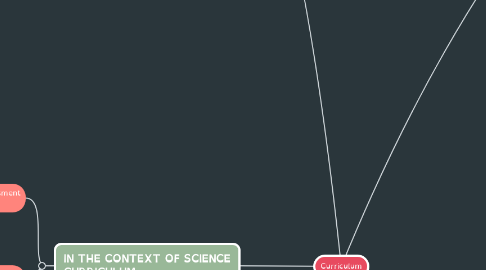
1. Categories
1.1. Cognitive
1.2. Affective
1.3. Psychomotor
2. As a concept
2.1. Elements
2.1.1. Purpose
2.1.1.1. Goals
2.1.1.1.1. Source
2.1.1.1.2. Levels
2.1.1.2. Objectives
2.1.2. Content
2.1.3. Methods
2.1.4. Evaluation
2.2. Perspectives
2.2.1. Rationalism
2.2.2. Empiricism
2.2.3. Pragmatism
2.2.4. Existentialism
2.3. Types
2.3.1. Formal
2.3.2. Informal
2.3.3. Actual
2.3.4. Core
2.3.5. Extra-Mural
2.3.6. Hidden/Collateral
3. IN THE CONTEXT OF SCIENCE CURRICULUM
3.1. Curriculum-Instruction-Assessment Triad
3.1.1. Curriculum
3.1.2. Instruction
3.1.3. Assessment
3.2. Salient features of Science Instruction
3.2.1. Curriculum
3.2.1.1. Consideration for the Learners
3.2.1.2. Learning Activities.
3.2.1.3. Assessment
3.3. Assessment in science instruction
3.3.1. Types
3.3.1.1. Formative Assessment
3.3.1.2. Summative Assessment
4. SCHOOL CURRICULUM AND INSTRUCTION
4.1. Definitions
4.1.1. Source of content
4.1.2. A group of people select the content
4.1.3. Learner expects a change of behavior after program
4.2. Reason
4.2.1. the capacity of the learner
4.2.2. the manipulative skills of the learner
4.2.3. the attitudes and value systems of the learner
4.3. Factors
4.3.1. National Goals of Education
4.3.2. Number of Subject Options Available
4.3.3. Resource Availability
4.3.4. The Learner
4.4. Process
4.4.1. Diagnosis of Needs
4.4.1.1. asks
4.4.1.1.1. Who are the learners?
4.4.1.1.2. Who are the teachers?
4.4.1.1.3. Why is the program necessary?
4.4.1.1.4. Where will the program be implemented?
4.4.1.1.5. How will it be implemented?
4.4.2. Formulation of Objectives
4.4.3. Selection of Content
4.4.4. Organization of Content
4.4.5. Selection of Learning Experiences
4.4.6. Organization of Learning Experiences
4.4.7. Evaluation
4.5. Curriculum Development and Instructional Development
4.5.1. Curriculum Development
4.5.1.1. Develop curriculum goals
4.5.1.2. Make curriculum planning decisions
4.5.1.3. Obtain school-related and community-related data
4.5.1.4. Determine curriculum content
4.5.1.5. Make curriculum content decisions
4.5.2. Instruction Development
4.5.2.1. Write a lesson plan
4.5.2.2. Plan a unit
4.5.2.3. Obtain student instructional resources
4.5.2.4. Develop learning experiences
4.5.2.5. Select media
4.5.2.6. Select equipment obtain supplies
4.5.2.7. Prepare teacher-made instructional materials
5. Shared Aspects
5.1. Writing objectives
5.2. Sequence Objectives
5.3. Determine Student Needs and Interests
5.4. Develop Curriculum Materials
5.5. Evaluate Curriculum Materials Effectiveness
6. Approaches
6.1. Planning
6.1.1. Assessment
6.1.2. Determinants
6.1.2.1. Learners psychological preparation
6.1.2.2. Learning Theory
6.1.2.3. Acquiring knowledge
6.1.2.4. Societal considerations
6.1.2.5. Political Factor
6.1.2.6. Social Factor
6.1.2.7. Economic Factor
6.1.2.8. Technological Factors
6.1.2.9. Environmental Factors
6.2. Design
6.2.1. Objectives model
6.2.2. Process model
6.2.3. Tyler’s model
6.2.4. Wheeler’s model
6.2.5. Kerr’s model
6.3. Task Analysis Process
6.3.1. Establish or obtain general goals of education
6.3.2. Selection of Content
6.3.2.1. Validity
6.3.2.2. Significance/relevance
6.3.2.3. Balance
6.3.2.4. Learnability
6.3.2.5. Appropriateness
6.3.2.6. Utility
6.3.3. Identify teacher role
6.3.4. Selection of Learning Experience
6.3.5. Time allotment
6.3.6. Identify student behavior and role
6.3.7. Evaluate to see if the intended outcomes have been achieved
6.4. Dimensions
6.4.1. Basics
6.4.2. Articulation and Alignment
6.4.2.1. Horizontal alignment
6.4.2.2. Vertical alignment
6.4.3. Alignment and Articulation in International Context
6.4.4. Scope
6.4.5. Integrations
6.4.6. Continuity and Progression
6.4.7. Conceptual understanding
6.4.8. Procedural understanding
6.4.9. Sequence
6.4.9.1. Topical Sequencing
6.4.9.2. Spiral Sequencing
6.5. Implementation
6.5.1. Factors
6.5.1.1. Teacher
6.5.1.2. Learners
6.5.1.3. Resource Materials and Facilities
6.5.1.4. Stakeholders
6.5.1.5. School Environment
6.5.1.6. Culture and Ideology
6.5.1.7. Instructional Supervision
6.5.1.8. Assessment
6.6. Evaluation
6.6.1. Areas
6.6.1.1. Mission statement
6.6.1.2. Sequence
6.6.1.3. Continuity
6.6.1.4. Scope
6.6.1.5. Articulation
6.6.1.6. Balance
6.6.1.7. Coherence
6.6.2. Approaches
6.6.2.1. Bureaucratic
6.6.2.2. Autocratic
6.6.2.3. Democratic
6.6.2.4. Non-Referenced
6.6.2.5. Criterion-Referenced
6.6.3. Forms
6.6.3.1. Formative
6.6.3.2. Summative
6.7. Improvement/ Change
6.7.1. Sources of Curriculum Change and Innovation
6.7.1.1. Policy Decision
6.7.1.2. Internationalization
6.7.1.3. Technological change
6.7.1.3.1. Types of Change
6.7.1.3.2. Forms of Change
6.7.1.4. Strategies and Models for Curriculum Change and Innovation
6.7.1.4.1. Participative Problem-Solving
6.7.1.4.2. Planned Linkage
6.7.1.4.3. Coercive Strategies
6.7.1.4.4. Open Input Strategies
6.7.1.5. Models of Curricular Innovation
6.7.1.5.1. The Research, Development and Diffusion Model
6.7.1.5.2. Problem-Solving Model
6.7.1.5.3. Social Interaction Model
6.7.1.5.4. Conditions for Successful Implementation of Innovations
7. Learning Domains
7.1. Cognitive
7.1.1. Knowledge
7.1.2. Comprehension
7.1.3. Application
7.1.4. Analysis
7.1.5. Synthesis
7.1.6. Evaluation
7.2. Affective
7.2.1. Receiving
7.2.2. Responding to Phenomena
7.2.3. Valuing
7.2.4. Organization
7.2.5. Characterization
7.3. Psychomotor
7.3.1. Taxonomy
7.3.1.1. Simpson (1972)
7.3.1.1.1. Perception
7.3.1.1.2. Set
7.3.1.1.3. Guided Response
7.3.1.1.4. Mechanism
7.3.1.1.5. Complex Overt Response
7.3.1.1.6. Adaptation
7.3.1.1.7. Origination
7.3.1.2. Dave (1975)
7.3.1.2.1. Imitation
7.3.1.2.2. Manipulation
7.3.1.2.3. Precision
7.3.1.2.4. Articulation
7.3.1.2.5. Naturalization
7.3.1.3. Harrow (1972)
7.3.1.3.1. Reflex movements
7.3.1.3.2. Basic fundamental movement
7.3.1.3.3. Perceptual
7.3.1.3.4. Physical activities
7.3.1.3.5. Skilled movements
7.3.1.3.6. Non-discursive communication
